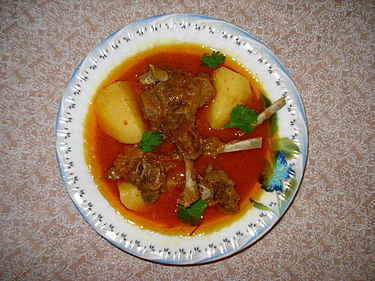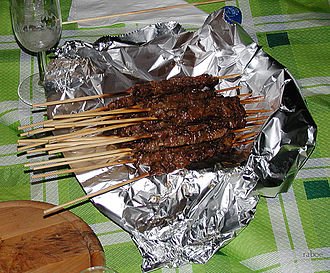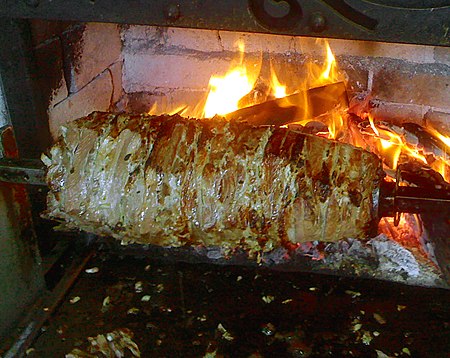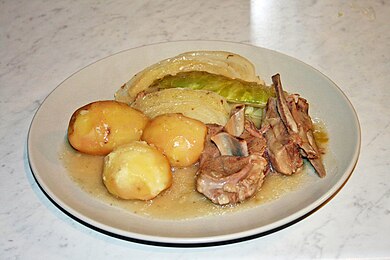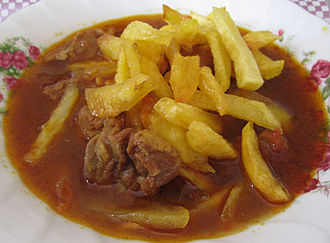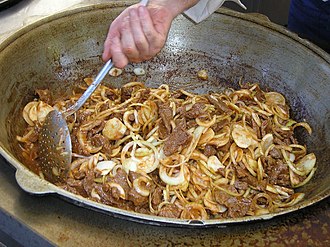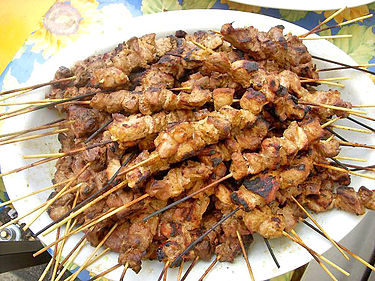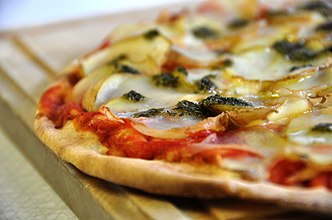https://en.wikipedia.org/wiki/List_of_lamb_dishes
양고기 다짐육을 사서 키마 커리를 하려고 전에 올린 글과 책을 참고하고 있는데 다른 양고기 요리도 하나씩 볼 겸 위키피디아를 긁어왔다.
양고기를 쉽게 살 수가 없어서 쉽게 접하게 되는 음식은 아니지만 호기심을 자극하는 음식이 많다.
음식 리스트는 꽤 긴데 사진이 있는 것도 있고 몇 개 생략한 것도 있는 것 같은데 기억이 잘 안난다;;
애초에 지난 달에 올리려던 것인데 두세시간 걸린 걸 쓰고 한 번 날려먹고 새로 쓰려니 힘들어서 한참 묵였다 다시 올려본다.
중간중간 사진이 없는 것이 있어서 헷갈릴 수 있는데 사진 밑에 있는 것이 사진의 음식이름과 설명이다.
이미지가 위키가 출처가 아닌 것은 사진 아래 링크를 따로 달았다.
http://turmericsaffron.blogspot.kr/2013/02/dizi-traditional-iranian-lamb-chickpea.html
- Abgoosht - Persian and Mesopotamian stew. Ābgusht is usually made with lamb, chickpeas, white beans, onion, potatoes, and tomatoes, turmeric, and dried lime.
- Alinazik kebab - home-style Turkish dish. It is made from smoked and spiced eggplant, grilled and then pureed, topped with cubes of sauteed lamb, previously seasoned and marinated. It is usually served with rice pilaf, grilled vegetables, and melted butter.
- Aloo gosht - meat curry in North Indian and Pakistani cuisine. It consists of potatoes (aloo) cooked with meat (gosht), usually lamb or mutton, in a stew-like shorba gravy. The dish can be served and eaten with plain rice or with bread such as roti, paratha or naan.
- Arrosticini - class of traditional dish from the Italian region of Abruzzo. Arrosticini (rustelle or arrustelle in the local dialects; also known as spierini or spidducc') are typically made from castrated sheep's meat (mutton), cut in chunks and pierced by a skewer.
- Beyti kebab - Turkish dish consisting of ground beef or lamb, grilled on a skewer and served wrapped in lavash and topped with tomato sauce and yogurt.
- Biryani - mixed rice dish from the Indian Subcontinent. It is made with spices, rice and meat or vegetables.
- Blessed thistle with lamb - dish common to the Aegean coast and Aegean sea islands among Turkish and Greek people. Ingredients include Blessed thistle, lamb chunks, onion, juice of half a lemon, flour, butter, and salt.
- Cağ kebabı - rotating kebab variety, originating in Turkey's Erzurum Province
- Cawl - Welsh dish. In modern Welsh the word is used to refer to any soup or broth. In English the word is used to refer to a traditional Welsh soup.
- Ćevapi - grilled dish of minced meat, a type of skinless sausage, found traditionally in the countries of southeastern Europe (the Balkans).
- Chakapuli - Georgianstew. It is considered to be one of the most popular dishes in Georgia.
- It is made from lamb chops or veal, onions, tarragon leaves, cherry plums or tkemali (cherry plum sauce), dry white wine, mixed fresh herbs (parsley, mint, dill, cilantro), garlic and salt
- Chanakhi - Georgian dish of lamb stew with tomatoes, aubergines, potatoes, greens and garlic.
- Chegdermeh - Turkmen traditional food that is cooked simultaneously with rice, meat (usually mutton or lamb), tomato paste or tomato and onions with oil, water and add-ons such as salt and pepper.
- Colonial goose - is a preparation of roast leg of lamb or mutton popular as a dish in New Zealand until the last quarter of the 20th century.
- Corn poppy with lamb - Gelincik yemeği) this dish commonly used by Aegean coast and Aegean sea islands Turkish and Greek people.
Ingredients typically include corn poppy, lamb chunks, onion, juice of half a lemon, flour, butter and salt.
- Dalcha - also known as Kaddu ka Dalcha is an Hyderabadi, Indian stew made from mutton, chana dal and Tamarind. It is a dish of Hyderabadi cuisine. The other variety, Kaddu ka Dalcha, is also a popular Hyderabadi dish.
- Devilled kidneys - Victorian British breakfast dish consisting of lamb's kidneys cooked in a spiced sauce, referred to as "devilling". It has since become more frequently used as a supper-time dish, and is regularly featured in cookbooks and by celebrity chefs.
- Dhansak - popular Indian dish, especially among the Parsi Zoroastrian community. It combines elements of Persian and Gujarati cuisine. Dhansak is made by cooking mutton with a mixture of lentils and vegetables. This is served with caramelised brown rice, which is rice cooked in caramel water to give it a typical taste and colour. The dal cooked with mutton and vegetables served with brown rice, altogether is called dhansak.
- Doner kebab - Turkish dish made of meat cooked on a vertical rotisserie, normally lamb but sometimes a mixture with veal, beef, or chicken.
- Not to be confused with Kebab.
- This article is about the Turkish dish. For the Arab version, see Shawarma. For Greek version, see Gyro (food).
- Fahsa - Yemeni stew. It is made of lamb cutlets with lamb broth. Spices and "holba" (fenugreek) are added after cooking.
- Fårikål - is a traditional Norwegian dish, consisting of pieces of mutton with bone, cabbage, whole black pepper and often a little wheat flour, cooked for several hours in a casserole, traditionally served with potatoes boiled in their jackets. The dish is typically prepared in early autumn.
- Fennel with lamb - (Turkish: Arapsaçı yemeği) is a dish from the Aegean coast and Aegean Sea islands among both Turkish and Greek people.
- Gheimeh - Persian and Mesopotamian stew (khoresh) consisting of meat, tomatoes, split peas, onion and dried lime. This stew is garnished with aubergine and/or French fries and usually served with rice.
- Grjúpán - an Icelandic dish that was eaten in earlier centuries in Iceland. It was the lungs of a sheep which was smoked with added salt and water.
Grjúpán however, has also long been used as a synonym of another kind of mutton sausage, bjúga, in Iceland.
- Haggis - Haggis is a savoury pudding containing sheep's pluck (heart, liver and lungs); minced with onion, oatmeal, suet, spices, and salt, mixed with stock, traditionally encased in the animal's stomach though now often in an artificial casing instead. According to the 2001 English edition of the Larousse Gastronomique: "Although its description is not immediately appealing, haggis has an excellent nutty texture and delicious savoury flavour".
- Hangikjöt - Hangikjöt (Icelandic pronunciation: [ˈhauɲcɪcœːt]; lit. "hung meat") is a traditional festive food in Iceland, served at Christmas.
- Instant-boiled mutton - Instant-boiled mutton (Chinese: 涮羊肉; pinyin: Shuàn Yángròu) is a Chinese hot pot dish. Instant-boiled mutton, also known as Mongolian Fire Pot or dip-boil mutton, is a Chinese hot pot dish. Traditionally, Chinese people have eaten it inside the home during cold winter weather, but in recent times, instant-boiled mutton has been eaten year-round. It is also eaten in restaurants.The dish often uses mutton from the back, rear legs, or tail of the lamb.
- Jalamah (food) - Jalamah is the traditional dish of Asir, native to Bareg .Jalamahis made from Lamb (meat), and a mixture of spices. The meat used is usually a young and small sized lamb to enhance the taste further.
- Jameed - Jameed (Arabic: جميد, literally "hardened") is a Jordanian food consisting of hard dry laban made from ewe or goat's milk. Milk is kept in a fine woven cheesecloth to make a thick yogurt.
- Jingisukan - Jingisukan (ジンギスカン?, "Genghis Khan") is a Japanese grilled mutton dish prepared on a convex metal skillet or other grill. The dish is particularly popular on the northern island of Hokkaidō, in China and in Thailand.
- Kabuli Palaw - Kabuli Palaw, also called Qabili Pulao (Pashto: کابلي پلاو; Persian: کابلی پلو) or simply pilav, is an Afghan pilaf dish consisting of steamed rice mixed with raisins, carrots, and lamb. It is one of the most popular dishes in Afghanistan and is considered the Afghan national dish. It is named after the city of Kabul, the capital of Afghanistan. It is also popular among the Pashtun people of Pakistan.
- Kairi ka do pyaza - Kairi ka do pyaza is an lamb meat preparation along with unripe green mangoes from Hyderabad, India. Its origin is from Hyderabadi cuisine, and is popular among Hyderabadi Muslims. Dopiaza is an onion gravy preparation with a souring agent. Various main ingredients are used to prepare different versions of do pyaza. Tomatoes, lemons, gooseberries or unripe green mangoes are the usual souring agents used. One can also prepare a vegetarian do pyaza without adding meat. The acetic flavor of the unripe sour green mangoes in the current recipe adds a distinct kick to the curry.
- Kebab - Kebab, (also kebap, kabob, kebob, kabab, or shishkebab) is a Middle Eastern, Eastern Mediterranean, and South Asian dish of pieces of meat, fish, or vegetables roasted or grilled on a skewer or spit originating in the Eastern Mediterranean, where it is mentioned by Homer, or the Middle East, and later adopted in Central Asia and by the regions of the former Mongol Empire and later Ottoman Empire, before spreading worldwide. In American English, kebab with no qualification refers to shish kebab (Turkish: şiş kebap) cooked on a skewer,[7] whereas in Europe it refers to doner kebab, sliced meat served in a pita. In the Middle East, however, kebab refers to meat that is cooked over or next to flames; large or small cuts of meat, or even ground meat; it may be served on plates, in sandwiches, or in bowls
- Khorkhog - Khorkhog (Mongolian: Xopxoг) is a barbecue dish in Mongolian cuisine. Khorkhog (horhog) is made by cooking pieces of meat inside a container which also contains hot stones and water, and is often also heated from the outside.
- Kibbeh nayyeh - Kibbeh nayyeh or raw kibbeh (Arabic: كبة نيئة) is a common Levantine mezze. It consists of minced raw lamb or beef mixed with fine bulgur and spices. Kibbeh nayyeh is often served with mint leaves, olive oil, and green onions. Arabic bread is used to scoop it. Sometimes a sauce of garlic or olive oil is served. The dish has a unique versatility in that any leftovers are cooked, creating a different dish.
- Kokoretsi - Kokoreç or Kokoretsi is a dish of the Balkans and Anatolia consisting mainly of lamb or goat intestines, often wrapping seasoned offal, including sweetbreads, hearts, lungs, or kidneys. The intestines of suckling lambs are preferred.
- Kol böreği - Kol böreği ("Arm börek") is a Turkish puff pastry prepared in long rolls, traditionally filled with cheese, potatoes, spinach, or meat, and baked at a low temperature. They are named after their long arm-like appearance.
- Kuurdak - Kuurdak (Kyrgyz: куурдак, Kazakh: куырдак, Turkmen: gowurdak, Uzbek: qovurdoq), transliterated with various spellings, is a traditional meat dish made in Central Asia, especially among the Kyrgyz. The name comes from a nominalisation of the word "roast", "fried", referring to how the food is made. It is described as "stewed brown meat".
- Laal maans - Laal maans (Hindi: लाल मांस; lit. "red mutton") is a meat curry from Rajasthan, India. It is a mutton curry prepared in a sauce of curd and hot spices such as red chillies. This dish typically is very hot and rich in garlic, the gravy may be thick or liquid and is eaten with chapatis made out of wheat (usually eaten in summers) or bajra (a millet grown in Rajasthan and eaten in the winter months).
- Lahndi (food) - Lahndi, also known as dried meat, is a winter food popular in northern Afghanistan. Consumption of lahndi is common during the winter months. Sheep are specially fattened so that their flesh may be more suitable for preparing lahndi.
- Lamb chop (meat) - A meat chop is a cut of meat cut perpendicularly to the spine, and usually containing a rib or riblet part of a vertebra and served as an individual portion. The most common kinds of meat chops are pork and lamb. A thin boneless chop, or one with only the rib bone, may be called a cutlet, though the difference is not always clear. The term "chop" is not usually used for beef, but a T-bone steak is essentially a loin chop, and a rib steak a rib chop.
- Lamb fries - Lamb fries are lamb testicles used as food. Historically they were parboiled, cut in half, and seasoned. Lamb testicles are served in a variety of cuisines, including Italian, American Basque, barbecue, Chinese, Caucasian, and Turkish. In the United States they are often served breaded and fried.
- Lamb's fry - Lamb's fry is lamb offal served as food, including the testicles, liver, sweetbreads, heart, kidneys, and sometimes the brain and abdominal fat—or some combination of these. In Australia and New Zealand, lamb's fry is specifically the liver; in the United States, "lamb fries" (q.v.) are specifically the testicles. In the U.K., it was all offal, though recently testicle has become rare.
- Lancashire hotpot - Lancashire hotpot is a dish made traditionally from lamb or mutton and onion, topped with sliced potatoes, left to bake in the oven all day in a heavy pot and on a low heat. Originating in the days of heavy industrialisation in Lancashire in the North West of England, it requires a minimum of effort to prepare.
- Lechazo - Lechazo is a Spanish dish made from "cordero lechal". The meat used is from unweaned lambs, and is similar to veal, or the meat of "cochinillo", Spanish suckling pigs. The province of Castilla y Leon has a distinctive version of lechazo referred to as "Lechazo de Castilla y Leon". Aranda de Duero is known as the heart of the dish, with numerous restaurants that specialize in lechazo and feature "hornos de leña", or wooden stoves, in which the lamb is roasted.
- Lunggoi Katsa - In Tibetan cuisine, Lunggoi Katsa is stewed sheep's head, with curry, fennel, monosodium glutamate and salt.
- Macon (food) - Macon is a food item that is prepared from mutton(i.e. adult sheep meat). Macon is prepared in a similar manner to bacon, with the meat being cured by soaking it in large quantities of salt or brine.
- Mallow with lamb - Mallow with lamb (Turkish: Etli Ebegümeci yemeği) is a dish from the Aegean coast and Aegean Sea islands among both Turkish and Greek people.
- Mansaf - Mansaf (Arabic: منسف) is a traditional Jordanian dish made of lamb cooked in a sauce of fermented dried yogurt and served with rice or bulgur. It is the national dish of Jordan and it is also found in Palestine., Iraq, Syria, and Saudi Arabia. The name of the dish comes from the term "large tray" or "large dish".
- Méchoui - In the cuisine of Northern Africa, Méchoui is a whole sheep or a lamb spit-roasted on a barbecue. The word comes from the Arabic word šawa, which means "grilled, roasted". This dish is very popular in North Africa.
- Mixiote - A mixiote is a traditional pit-barbecued meat dish in central Mexico; especially in the Basin of Mexico. It can also be prepared in an oven. It is usually made with mutton or rabbit, but chicken, lamb, and pork are also used. The meat is cubed with the bone and seasoned with pasilla and guajillo chili peppers, cumin, thyme, marjoram, bay leaves, cloves and garlic. It is then wrapped in small packages made of the tough semi-transparent outer skin of the leaves of the maguey or century plant, which gives it a unique flavor. Diced nopales are often included with the meat before wrapping.
- Moussaka - Moussaka is an eggplant- (aubergine) or potato-based dish, often including ground meat, in the cuisines of the countries of the former Ottoman Empire, with many local and regional variations.In Turkey, it is sautéed and served in the style of a casserole, and consumed warm or at room temperature. In Arabic countries, a variant is eaten cold. In the Balkans, the dish is layered and typically served hot.
- Murtabak - Murtabak or martabak, also mutabbaq (Arabic: مطبق) (Thai: มะตะบะ), is a stuffed pancake or pan-fried bread which is commonly found in Saudi Arabia (especially the Tihamah and the Hejaz regions), Yemen, India, Indonesia, Malaysia, Singapore, Brunei and Thailand. Depending on the location, the name and ingredients can significantly vary. The name mutabbaq (or sometimes mutabbag) in Arabic means "folded". In Indonesia, the Murtabak is one of the most popular street foods and is known as "martabak".
- Mutton pulao - Mutton Pulao is a dish fairly common in North Indian and Pakistani cuisine that incorporates mutton into a rice pilaf.The rice used is almost invariably Basmati or a close variant. Even though Mutton Pulao resembles Mutton Biryani in many respects, there are subtle differences, apparent largely in the use of different set of spices.
http://gochaselife.com/4-amazing-meals-to-celebrate-eid-with/
- Naan qalia - Naan qalia is a dish that originates from Aurangabad in India. It is a concoction of mutton and a variety of spices. Naan is a bread made in a tandoor (hot furnace), while qalia is a mixture of mutton and various spices.
- Navarin (food) - Navarin is a French ragoût (stew) of lamb or mutton. If made with lamb and vegetables available fresh in the spring, it is called navarin printanier (spring stew). While the name "navarin" has been suggested to honor the 1827 Battle of Navarino, more probably it refers to the stew's traditional inclusion of turnips – navet, in French.
- Paomo - Paomo (Chinese: 泡馍; pinyin: pàomó; literally: "soaked mó") is a specialty of Shaanxi cuisine and is a typical food eaten in the city of Xi'an. It is a hot stew of chopped-up steamed leavened bread (known regionally as mo or mantou, simplified Chinese: 馍; traditional Chinese: 饃; pinyin: mó or simplified Chinese: 馒头; traditional Chinese: 饅頭; pinyin: mántóu), cooked in lamb broth and served with lamb meat, sometimes substituted with beef.
- Pasanda - Pasanda (Urdu: پسندہ) is a popular North Indian and Pakistani meat dish, derived from a meal served in the Court of the Moghul Emperors. The word is a variation on the Urdu word "pasande" meaning "favourite", which refers to the prime cut of meat traditionally used within.
- Pieds paquets - Pieds paquets or pied et paquets (literally, feet packet or feet and packages in French) is a local dish and culinary specialty of Marseille and Sisteron but also commonly found in much of Southeastern France. It consists of sheep's feet and stuffed sheep's tripe stewed together.
- Pinchitos - Pinchitos or Pinchos Morunos is a (believed to be) North African influenced dish typical of the Spanish autonomous communities of Andalusia and Extremadura. It consists of small cubes of meat threaded onto a skewer (Spanish: pincho) which are traditionally cooked over charcoal braziers.
- Pinnekjøtt - In Norway, Pinnekjøtt is a main course dinner dish of lamb or mutton. Pinnekjøtt is a festive dish typical to Western- and Northern Norway, and is rapidly gaining popularity in other regions as well. This dish is largely associated with the celebration of Christmas, served with puréed swede and potatoes, beer and akevitt. 37% of Norwegians say they eat pinnekjøtt for their family Christmas dinner.
- Pleşcoi sausages - Pleșcoi sausages are a Romanian sausage made from mutton spiced with chili peppers and garlic, traditionally made in and around the Pleșcoi village, in the Buzău County of Romania. If the mutton contains too much fat, it can be balanced with beef, but with no more than half of the mutton content.
http://food.sulekha.com/keema-kabab.htm
- Qeema - Keema or Qeema or Morteza (pronounced [ˈqiːmaː]) is a traditional South Asian meat dish, derived from Persian qeymeh. The name qeema is an ancient Akkadian word meaning 'finely chopped'. The word may also be borrowed probably from Greek χυμὸς and originally meant minced meat. Another theory is about its Turkic origin. It is typically minced mutton curry (lamb or goat) with peas or potatoes. Keema can be made from almost any meat, can be cooked by stewing or frying, and can be formed into kababs. Keema is also sometimes used as a filling for samosas or naan. The word for a similar dish in Armenian is "Gheymah" ղեյմա and in Turkish "kıyma" means minced meat.
- Quzi - Quzi (Arabic: قوزي) is a rice based dish popular in Iraq. It is served with very slow cooked lamb and roasted nuts and raisins.
- Rack of lamb - A rack of lamb or carré d'agneau (though this may also refer to other cuts) is a cut of lamb cut perpendicularly to the spine, and including 16 ribs or chops. At retail, it is usually sold 'single' (sawn longitudinally and including the 8 ribs on one side only), but may also be sold as a "double rack of lamb", with the ribs on both sides. Alternatively two French trimmed racks may be placed together with the ribs interlinked, when configured this way it is often known as a 'Guard of Honour' . Rack of lamb is usually roasted, sometimes first coated with an herbed breadcrumb persillade. The tips of the bones are sometimes decorated with paper frills called manchettes.
- Ribberull - Ribberull is a Norwegian dish consisting of lamb shoulder boned, flattened, sewn to form a long rectangle, rolled, pressed, and steamed.It is similar in concept to Danish rullepølse, which is made from pork.
- Roast lamb with laver sauce - Roast lamb with laver sauce is a recipe associated with Wales and Welsh cuisine. Lamb and mutton dishes are widespread and common in all the old counties of Wales and have long been traditional, with all regions having their own variations and contribution, let alone the various sheep breeds, to make to a lamb dish worthy of being the national dish.
- Rogan josh - Rogan josh (or roghan josh) (pronounced /rouɣændʒuːʃ/ in Persian), is an aromatic lamb dish of Persian origin, which is one of the signature recipes of Kashmiri cuisine. Roughan (روغن) means "clarified butter" or "fat" in Persian, while juš (جوش) (alternatively romanised josh), gives the figurative meaning of "intensity" or "passion" and ultimately derives from the verb jušidan (جوشيدن) meaning "to heat". Rogan josh thus means cooked in oil at intense heat. Another interpretation of the name rogan josh is derived from the word rogan meaning "red color" (the same Indo-European root that is the source of the French "rouge" and the Spanish "rojo") and josh meaning passion or heat.
- Sajji - Sajji is a popular dish in Balochistan province of Pakistan. It consists of whole lamb, in skewers (fat and meat intact), marinated only in salt, sometimes covered with green papaya paste, stuffed with rice, then roasted over coals. Sajji is considered done when it is at the 'rare' stage. It is served with a special bread "Kaak", "roti" or "naan", which is baked in an oven, wrapped around a stone "tandoor". Sajji is favourite dish of Baloch people and is available in all regions of Pakistan. Regional varieties are found with subtle differences in flavouring notably in the urban centres of Karachi, Islamabad or Lahore, uses chicken instead of lamb, and is roasted until it is medium or well-done.
- Sarburma - Sarburma (Turkish: Etli kol böreği ) (also known simply as Burma in the Crimean Highlands among Tats; in Crimean sarmaq means to wrap and burmaq to curl, Ukrainian: сарбурма) is a Crimean traditional meat pie dish originating among ethnic Crimeans, currently widespread snack in Crimea.
- Scotch broth- Scotch broth is a filling soup, originating in Scotland but now obtainable worldwide. The principal ingredients are usually barley, stewing or braising cuts of lamb, mutton or beef, root vegetables such as carrots, swedes or sometimes turnips and dried pulses (most often split peas and red lentils). Cabbage and leeks are often added shortly before serving to preserve their texture, colour and flavours. The proportions and ingredients vary according to the recipe or availability. Scotch broth has been sold ready-prepared in cans for many years. Today there are also vegetarian and vegan versions of Scotch broth.
- Scotch pie - A Scotch pie or mutton pie is a small, double-crust meat pie filled with minced mutton or other meat.[1] It may also be known as a shell pie or mince pie (although the latter term is ambiguous) to differentiate it from other varieties of savoury pie, such as the steak pie, steak and kidney pie, steak-and-tattie (potato) pie, and so forth. The Scotch pie is believed to originate in Scotland, but can be found in other parts of the United Kingdom, and is widely sold all over Canada. They are often sold alongside other types of hot food in football grounds, traditionally accompanied by a drink of Bovril, resulting in the occasional reference to football pies.
- Scouse (food) - Scouse is a type of lamb or beef stew. The word comes from lobscouse, a stew commonly eaten by sailors throughout Northern Europe, which became popular in seaports such as Liverpool.
- Sfiha - Sfiha (Arabic: صفيحة sfīḥah), is a pizza-like dish originating from the Levant, but it is also known in Turkey as pide. It was introduced in Brazil by Levantine immigrants, where it is known as esfiha.
- Sha Shingbee - Sha Shingbee is a stir-fry type dish of sliced mutton with green beans in Tibetan cuisine.
- Shepherd's pie - Cottage pie or shepherd's pie is a meat pie with a crust of mashed potato.
- Skerpikjøt - Skerpikjøt, a type of wind-dried mutton, is a delicacy of the Faroe Islands which is traditionally eaten at Christmas but also at other times of the year.
- Skilpadjies - Skilpadjies is a traditional South African food, also known by other names such as muise, vlermuise and pofadder. The dish is lamb's liver wrapped in netvet (caul fat), which is the fatty membrane that surrounds the kidneys. Most cooks mince the liver, add coriander, chopped onion, salt and Worcestershire sauce then wrap balls of this mixture with the netvet and secure it with a toothpick. The balls, approximately 80 mm (3.1 in) in diameter, are normally barbecued (grilled over an open fire) and ready when the fat is crisp.
- Smalahove - Smalahove (also called smalehovud or skjelte) is a Western Norwegian traditional dish made from a sheep's head, originally eaten before Christmas. The name of the dish comes from the combination of the Norwegian words hove and smale. Hove is a dialectal form of hovud, meaning head (cf. Hǫfuð), and smale is a word for sheep, so Smalahove literally means sheep head. The skin and fleece of the head is torched, the brain removed, and the head is salted, sometimes smoked, and dried. The head is boiled or steamed for about three hours, and is served with mashed rutabaga and potatoes. It is also traditionally served with Akvavit. In some preparations, the brain is cooked inside the skull and then eaten with a spoon or fried. Originally, smalahove was typically eaten by the poor, but today it is considered a delicacy.
- Sodd - Sodd is a traditional Norwegian soup-like meal with mutton and meatballs. Usually vegetables such as potatoes and/or carrots also are included. It is often a part of festive activities, such as weddings, in the middle parts of Norway together with water or ginger ale (Norw. ingefærøl).
- Sosatie - Sosatie (pl sosaties) is a traditional South African dish of meat (usually lamb or mutton) cooked on skewers. The term derives from sate ("skewered meat") and saus (spicy sauce). It is of Cape Malay origin, used in Afrikaans, the primary language of the Cape Malays, and the word has gained greater circulation in South Africa.Marinated, cubed meat (usually lamb) is skewered and barbecued shish-kebab style
- Squab pie - Squab pie is a traditional dish from South West England, with early records showing it was associated with Cornwall, Devon and Gloucestershire. Although the name suggests it contains squab (young domestic pigeon), in fact it contains mutton and apples. The pie was eaten around the world in the 1900s, though outside South West England it generally did contain pigeon. It is no longer a popular dish, with less than 3% of British teenagers surveyed having eaten it.
- Stuffed intestines - Stuffed intestines (Turkish: Mumbar dolması) is a dish from the Turkish cuisine. The main ingredients are minced meat, lamb’s intestines, rice, tomato paste, red pepper paste, butter, salt, black pepper, allspice, and cinnamon.
- Svið - Svið (pronounced [ˈsvɪːð]) is a traditional Icelandic dish consisting of a sheep's head cut in half, singed to remove the fur, and boiled with the brain removed, sometimes cured in lactic acid.
- Tavë kosi - Tavë kosi is a national dish in Albania. It is a simple dish of baked lamb and rice, served with a yogurt sauce.
- Tripoux - Tripoux (or Tripous) is a dish made with small bundles of sheep tripe, usually stuffed with sheep's feet, sweetbreads and various herbs and garden vegetables. There are a number of variations on this dish, but they generally all involve savoury ingredients held together with sheep tripe and braised over low heat.
- Wazwan - Wazwan is a multi-course meal in Kashmiri cuisine, the preparation of which is considered an art and a point of pride in Kashmiri Muslim culture and identity. Almost all the dishes are meat-based using lamb or chicken. It is popular throughout Kashmir, besides being served in India at major hotels and restaurants. Wazwan is also served internationally at Kashmiri food festivals and reunions.


